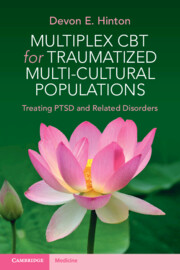Book contents
- Multiplex CBT for Traumatized Multicultural Populations
- Multiplex CBT for Traumatized Multicultural Populations
- Copyright page
- Contents
- Therapist Introduction
- Session 1 Education About Trauma-Related Disorder and the Introduction of Emotion Regulation Techniques
- Session 2 Applied Stretching and the Toe-to-Head Muscle Relaxation with Visualization
- Session 3 Review of the Toe-to-Head Muscle Relaxation with Visualization and the Introduction of the Anxiety Protocol
- Session 4 Education About Trauma and Introduction of the Trauma-Recall Protocol (TRP)
- Session 5 Education About Trauma-Related Disorder, Modification of Catastrophic Cognitions, and Teaching Emotional Distancing
- Session 6 Interoceptive Exposure with Reassociation I: Head Rotation
- Session 7 Interoceptive Exposure with Reassociation II: Hyperventilation
- Session 8 Education About Breathing and Its Use for Relaxation
- Session 9 Sleep Disturbance
- Session 10 Worry and Generalized Anxiety Disorder
- Session 11 Anger and Anger Protocol
- Session 12 Somatic Symptoms I and Review
- Session 13 Somatic Symptoms II and Review
- Session 14 Cultural Syndromes and Final Review
- Book part
- Index
- References
Therapist Introduction
Published online by Cambridge University Press: 22 May 2022
- Multiplex CBT for Traumatized Multicultural Populations
- Multiplex CBT for Traumatized Multicultural Populations
- Copyright page
- Contents
- Therapist Introduction
- Session 1 Education About Trauma-Related Disorder and the Introduction of Emotion Regulation Techniques
- Session 2 Applied Stretching and the Toe-to-Head Muscle Relaxation with Visualization
- Session 3 Review of the Toe-to-Head Muscle Relaxation with Visualization and the Introduction of the Anxiety Protocol
- Session 4 Education About Trauma and Introduction of the Trauma-Recall Protocol (TRP)
- Session 5 Education About Trauma-Related Disorder, Modification of Catastrophic Cognitions, and Teaching Emotional Distancing
- Session 6 Interoceptive Exposure with Reassociation I: Head Rotation
- Session 7 Interoceptive Exposure with Reassociation II: Hyperventilation
- Session 8 Education About Breathing and Its Use for Relaxation
- Session 9 Sleep Disturbance
- Session 10 Worry and Generalized Anxiety Disorder
- Session 11 Anger and Anger Protocol
- Session 12 Somatic Symptoms I and Review
- Session 13 Somatic Symptoms II and Review
- Session 14 Cultural Syndromes and Final Review
- Book part
- Index
- References
Summary
This chapter is a theoretical introduction to the treatment. This includes introduction to the model that guides treatment (the multiplex model), aspects of efficacy, and a review of studies supporting the approach.
- Type
- Chapter
- Information
- Multiplex CBT for Traumatized Multicultural PopulationsTreating PTSD and Related Disorders, pp. 1 - 24Publisher: Cambridge University PressPrint publication year: 2022

